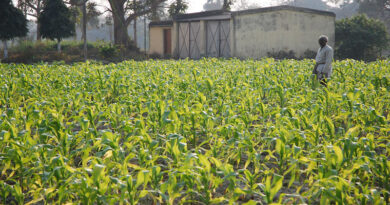How Much to Pay Your Right-Hand Farmhand
14 December 2023, US: What would you pay for peace of mind that someone knowledgeable is making sure that operations run smoothly on your farm? A farmhand often assists farmers in such daily agricultural tasks as growing crops, raising livestock, and general farm work. Hiring the right farmhand can help you produce the best quality product and scale your business.
A right-hand farmhand is often worth the investment. Determining an hourly wage or annual salary for a farmhand can be complex, though, as there are several factors to consider, including your own budget.
In this post, we’ll cover:
- The Average Farmhand Salary
- 4 Factors That Determine Salary for Farmhands
- Investing in Your Farm Workers
- What Should You Pay a Farmhand?
Along the way, we’ll reveal how you possibly can cover labor costs even when cash flow is tight.
The Average Farmhand Salary
As is the case for most jobs across industries, there is no set salary for agricultural workers that all farms follow. Thanks to more pay transparency laws that have been put in place in some states as well as websites that aggregate data, there is greater knowledge surrounding agricultural salaries. This helps employers and employees make informed decisions about what’s considered acceptable payment.
In 2023, pay rates ranged anywhere from $12.15 an hour to $22.93 an hour, according to Indeed, a jobs listings website that gathers this information from employers and jobseekers. It estimates that the average pay for a farmhand in the United States is currently $16.69/hour. In terms of an annual salary, it indicates that farmhand salaries range from $43,130 to $81,405. The average salary is $59,254.
However, Glassdoor, a website where workers can anonymously review their current or former employer, shows slightly lower pay rates for farmhands. The annual pay range is $36,000 to $54,000. Glassdoor gives the average salary of a farmhand as $40,989 a year.
4 Factors That Determine Salary for Farmhands
While pay discrepancy may seem surprising given the push for transparency, there are a number of reasons why one farmhand may get paid $36,000 a year while another gets paid $81,405. Agricultural employers consider several factors when determining the salary they will pay to farmhands.
Here are four considerations to keep in mind when determining salary.
1. Location
Geography plays a role in compensation. This is because the cost of living can vary greatly across the United States.
The state with the lowest cost of living index in the nation, according to the World Population Review, is Mississippi, where it is 83.3. Here, the average rent for an apartment with two bedrooms is $991, and the median price for a single-family home comes to $140,818. Because the cost of living is lower here, salaries are lower here too. In Mississippi, a family of four has a median income of $70,656.
Meanwhile, the state with the highest cost of living index is Hawaii, where it’s 193.3. Here, the average rent for an apartment with two bedrooms is $2,399, and the median price for a single-family home comes to $730,511. In Hawaii, a family of four has a median income of $118,223.
Hourly rates and annual salaries for farmhands factor in the cost of living where the farm is located. Using our above examples, a farmhand in Mississippi earns an average salary of $41,764, while a farmhand in Hawaii earns an average salary of $73,265, according to Indeed.
2. Experience
Farm workers are expected to be able to perform a wide variety of tasks. Common responsibilities include planting, fertilizing, and scouting crops; harvesting crops and examining their quality; cleaning stables, pens, and coops; detecting health issues in livestock; and driving tractors and other operating equipment.
The number of years one has worked in agriculture and the level of experience they have are important to assess. For example, a newer farmhand may have general experience feeding and tending to cattle, while a farmhand with more years of work may have greater understanding of how to deal with such issues as respiratory disease in newborn calves.
A newer farm worker should not be financially docked for knowledge and skills that take time to acquire. They may be passionate and a fast learner. However, it’s worth rewarding accomplished professionals who not only don’t require extensive training and oversight but who also have first-hand experience that they can draw from to solve problems.
3. Specialized Knowledge
The average education level for an agricultural worker in the United States is ninth grade, according to the National Center for Farmworker Health, Inc. Only 14% have had higher education.
College is not required to be successful as a farm worker. As with many trade jobs, the specialized training that farmhands need is often gained through hands-on experience or apprenticeships.
While there is a certain level of general knowledge and skills that farmhands should have, those who acquire specialized knowledge bring more authority to the position and can help farms reach their full potential.
Examples of specialized knowledge that a farmhand may possess include regenerative agriculture, organic farm best practices, leading agritourism at a vineyard, experience growing a particular flower — such as the hard-to-grow orchid — on a farm, and a background in aquaculture. These types of highly specialized skills won’t apply to all farms but can be incredibly useful on the right farm. Therefore, employers on specialized farms may wish to provide greater compensation to those workers with hard-to-find skill sets.
4. Technical Skills
Today’s farms are becoming more technologically advanced. In 2020, the agricultural technology (Agtech) market value worldwide was $9.1 billion. By 2025, it’s expected to have more than doubled to $22.57 billion. However, in 2020, only 31% of agricultural workers performed technical tasks.
As Agtech grows, there will be a greater need for workers who are skilled, for example, in flying drones to gather imagery to check on the health of plants, using sensors to monitor soil conditions, and operating autonomous tractors. Farmhands with technological skills command higher pay because they can perform tasks that other workers cannot do. For example, they may be able to make purchasing recommendations and decisions related to finding the right farm equipment.
Investing in Your Farm Workers
Farmhands are vital to the success of a farm. Even as farms invest in robots to automate repetitive tasks on farms, skilled farm workers are still needed to interpret data, oversee machinery, and add a personal touch to farm management.
It is therefore worth paying a farmhand not just a livable wage but one that takes into account the value they’re adding to the farm. In an era in which many workers change jobs frequently, having a competitive salary will help ensure worker loyalty.
What Should You Pay a Farmhand?
There is no one-size fits all approach to paying farmhands. Considerations such as the farm’s geographic location and the farmhand’s level of experience, specialized knowledge, and technical skills can factor into determining a fair salary.
As well, benefits such as health coverage — learn about FBN® Health here — disability insurance, paid time off, education and training, and profit sharing can be considered part of the overall payment package.
Also Read: High Sugar Prices Create Signs of Substitution Among US Manufacturers
(For Latest Agriculture News & Updates, follow Krishak Jagat on Google News)















